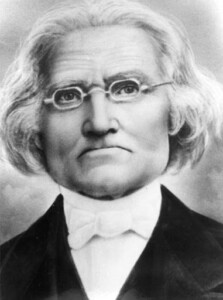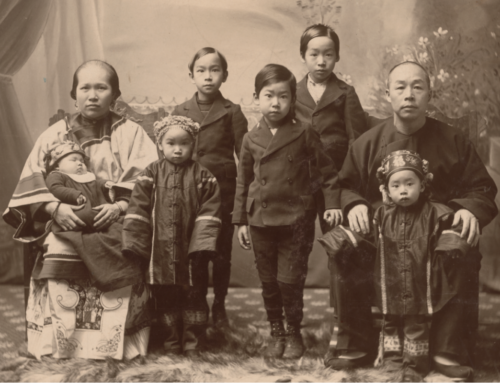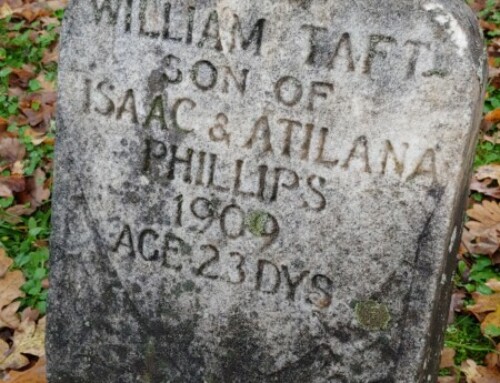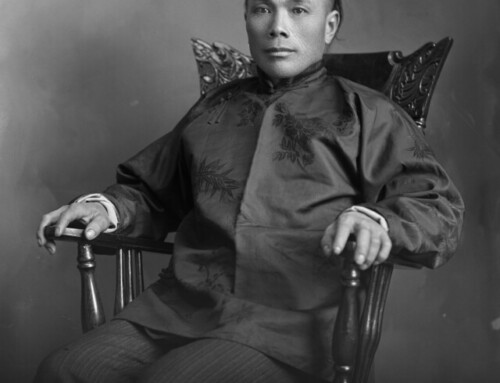David Leslie
(1787-1869)
Reverend David Leslie’s time at the Methodist mission in Salem was marked by tragedies, but the missionary persevered through personal hardships to make a lasting impact on the development of education and religion in Oregon. By the time the Salem mission closed in 1849, the Leslie’s personal and family life had suffered greatly for his twelve year service in Oregon. His first house in Oregon was destroyed in a fire. He witnessed the death of his first wife as well as other members of the mission. Three of his four daughters had died while far away from him. In only two and a half years, his family of seven was reduced to three. At the time the mission closed, Leslie was fifty-two years old; the resilient missionary would live twenty more years in Salem.
David Leslie was born in 1787 in Washington, New Hampshire, the son of a minister. Misfortune came early in his life as he lost his parents while still a child; he and his orphaned siblings were scattered. He was educated in Salem, Massachusetts, and then at the Wilbraham Academy, the same school attended by Jason Lee. Leslie specialized in modern languages, French being his specialty. He received a license to preach in 1820 at the age of thirty-seven. While serving in the New England Conference of the Methodist Episcopal Church, he had a close association with Jason Lee, who had returned from his mission in the Willamette Valley to raise money and recruit reinforcements for the mission. In 1836, Leslie volunteered to join his friend in Oregon, sailing around South America on the ship Sumatra with his wife, Mary A. Kinney Leslie, and their three daughters. Two more daughters were born to them here.
Soon after his arrival on September 7, 1837, Lee appointed Leslie as one of two magistrates for the territory south of the Columbia River. In March 1838, Leslie was left in charge of the mission while Lee again traveled to the East, and remained so for the next two years until Lee returned with the “Great Reinforcement.” In 1839, Leslie and William H. Willson established a satellite mission on the Puget Sound, at Nisqually. In August and September of 1840, Leslie led an exploration further north, through present-day Washington and British Columbia, nearly reaching the southern tip of Alaska, to scout out possible locations for other mission branches. By this time, the mission was in process of moving from its original location near Wheatland ferry to a new location ten miles to the south, near the Indian village of Chemeketa, the present site of Salem. Leslie took part in the manual labor of constructing the sawmill and building the dam. He also organized the Methodist Episcopal Church in Salem in 1841and served as its first pastor.
In February of the next year, Leslie’s wife Mary became ill and died. She was the first person buried in Salem’s Pioneer Cemetery, which was then part of Leslie’s land claim. Feeling ill-equipped to raise five daughters on his own in sparsely-settled Oregon, Leslie decided to take his girls to Hawaii where there was a well-established Methodist mission and a school for the girls. While in Astoria in September 1842, awaiting favorable winds for sailing, his daughter Satira slipped ashore and was married to a missionary, Cornelius Rogers. Although the marriage was sudden, Leslie accepted his daughter’s choice; Rogers was remembered as “an outstanding young man.” Leslie left two of his daughters, Helen and Aurelia, in the care of Satira and Cornelius, and proceeded to Hawaii where Mary and Sarah were left in a boarding school. Sadly, Sarah died there only a year later. Mary eventually returned to Salem and married George H. Jones. In February 1843, while Reverend Leslie was away from Oregon, his daughters Satira and Aurelia, along with Satira’s husband Cornelius Rogers, Nathaniel Crocker, and two Clatsop Indians were swept over the falls of the Willamette near Oregon City while canoeing and drowned.
In the Spring of 1843, Dr. Leslie returned to Salem and resumed his work at the mission. On January 7, the next year, he married Adelia Judson Olley, the widow of James Olley and sister of Rev. Lewis H. Judson. Reverend Judson’s two-year-old son Robert Thomas Judson came to live with the Leslie family. Leslie and his new wife had two daughters, Sarah and Emma. Sarah died in 1854 at age six; Emma the following year at age four. Of his seven daughters, Leslie outlived all but one. He was survived by his daughter Helen, who never married and lived with her stepmother Adelia until her death in 1890.
In 1843, Reverend George Gary was sent by the mission board in New York to reorganize, and eventually liquidate, the Salem mission. Gary was quartered in Leslie’s home, and the two men’s radically different opinions about the mission led to conflicts. Gary was misinformed about the mission and came with strong preconceived notions. As Lewis Judson, the grandson of Rev. Lewis H. Judson, characterizes him, Gary was “caustically critical of what had been done … was arrogant in his manner and contemptuous of the mission.” The conflict between Leslie and Gary, along with Leslie’s many personal tragedies, gave him a reputation as an angry and disagreeable man. However, this reputation may not have been deserved. Robert Judson, who was raised by Leslie, had many happy memories of his childhood there. After he had returned to his father’s house for a few years, Judson returned to Leslie’s house at his own request, where he was treated as the son Leslie never had.
When the mission was discontinued, Leslie was assigned the claim lying between what is now Mission and McGilchrist streets and between the east edge of Bush Pasture Park and Willamette Slough. Here he built the fourth house in Salem and planted an orchard with numerous varieties of apples and pears. In 1860, Leslie sold 100 acres of his property to Asahel Bush II, and Bush House now stands on the site of the Leslie’s home.
Leslie had been elected president of the board of trustees for the Oregon Institute, a school for settlers’ children, in 1845. he held this position through the Institute’s transition into Willamette University until his death. In 1867, he laid the cornerstone of Waller Hall, the first brick building on the Willamette campus. Leslie also was one of the founders of Salem’s Masonic Order chapter and the first chaplain of the territorial legislature and the Grand Lodge of A. F. and A. M. of Oregon.
In the last fifteen years of his life, Leslie became increasingly physically disabled, but his dignity and continued community involvement inspired the respect of all who knew him. He died March 1, 1869. Salem’s Daily Unionist newspaper reported that his funeral service, at the Methodist Episcopal Church he founded, “was crowded to its utmost capacity, and the procession to the cemetery, is said to have been the largest ever seen in this city. Our citizens united as of one common brotherhood, to pay the last marks of respect and honor, to the memory of this veteran in the ministry of the gospel, and early pioneer to the wilds of an unsettled wilderness.”
Written by Virginia Green and Katherine Wallig.
Bibliography:
“David Leslie.” Salem Pioneer Cemetery website. March 3, 2004. <http://www.open.org/~pioneerc/pg26.html#LeslDavi132> June 8, 2004.
Dobbs, Caroline C. “Reverend David Leslie.” Men of Champoeg. Portland: Metropolitan Press, 1932. Pages 60-63.
“Funeral of Father Leslie.” Daily Unionist. March 4, 1869. 3:1. Salem Pioneer Cemetery website. March 3, 2004. <http://www.open.org/~pioneerc/pg26.html#LeslDavi132> June 8, 2004.
Jones, Alfred C. “David Leslie, a founder of Salem, felt tragedies, triumphs.” Statesman Journal. [undated clipping] Hugh Morrow Pamphlet Collection, Salem Public Library.
Judson, Lewis. “David Leslie,” Marion County History, Volume III, June 1957, pages 13-15.
This article originally appeared on the original Salem Online History site and has not been updated since 2006.









Leave A Comment